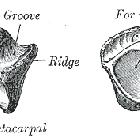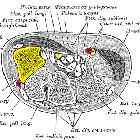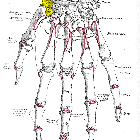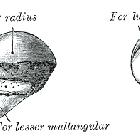Os trapezium








The trapezium (also known as the greater multangular) is one of the eight carpal bones of the hand. It is the most lateral (radial) bone of the distal row, located between the scaphoid and the first metacarpal bone. It articulates with the scaphoid proximally, the trapezoid medially, and the thumb and index metacarpals distally. The trapezium and trapezoid are collectively known as the multangulars.
Gross anatomy
Osteology
The trapezium has six surfaces in total:
Articulations
- articulates with the scaphoid at the midcarpal joint
- articulates with the trapezoid at its intercarpal joint
- articulates with the thumb metacarpal at the carpometacarpal joint of the thumb
Attachments
Musculotendinous
- superficial head of flexor pollicis brevis arises from the tubercle distally
- the opponens pollicis arises from the tubercle between flexor pollicis brevis and abductor pollicis brevis
- the abductor pollicis brevis arises from the tubercle proximally
Ligamentous
- two layers of the flexor retinaculum attach either side of the groove of the trapezium
- radial collateral ligament attaches to the lateral surface
- capsule of the carpometacarpal joint of the thumb attaches to the lateral surface
Relations
The tendon of flexor carpi radialis runs through the groove and the radial artery is directly related to the dorsal surface.
Arterial supply
Supplied by distal branches of the radial artery, primarily via the dorsal surface .
Venous supply
Drained by tributaries of the radial vein.
Radiographic features
Plain radiograph
The trapezium may be visualized on a number of series of the distal upper limb including:
Cross-sectional imaging
CT or MRI imaging will demonstrate the trapezium and should be considered if there is clinical suspicion of occult injury.
Development
Ossification
The trapezium begins to ossify in the fourth to fifth year.
Variant anatomy
Females have a significantly smaller sellar surface, with a fundamentally different shape of that surface .
History and etymology
Trapezium derives from the Ancient Greek: originally 'small table', later a four-sided figure with no parallel sides.
Related pathology
- base of thumb arthritis
- trapezium fracture
Siehe auch:
und weiter:

 Assoziationen und Differentialdiagnosen zu Os trapezium:
Assoziationen und Differentialdiagnosen zu Os trapezium:


